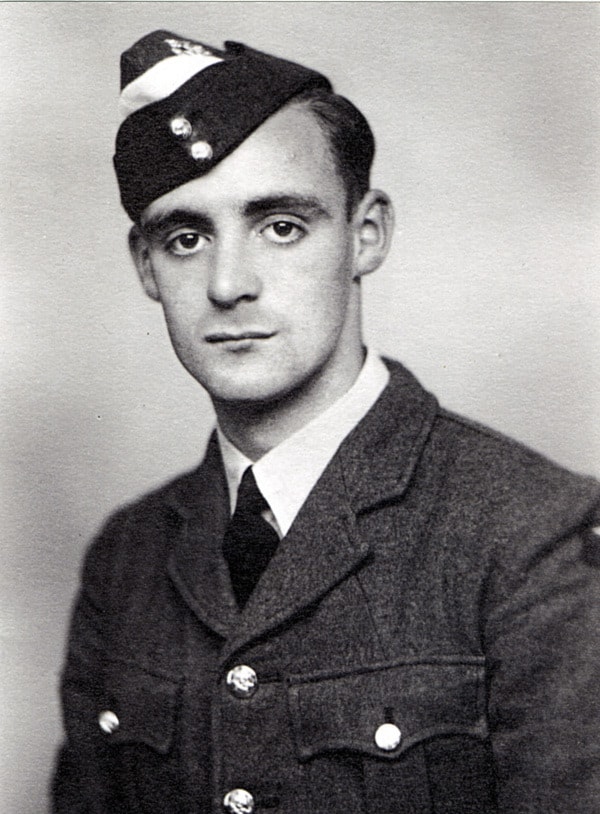He sits in the comfort of his living room chair, next to a window with a serene view of Shuswap Lake. His wife, Wendy, sits by his side.
Dean’s life here is calm and relaxed, the only indication of his involvement with war is the name of one of the two rescue dogs that lie at his feet.
Dixie, is a subtle nod to his days spent soaring through the skies as a navigator for Royal Air Force bomber command, a time when he was known as Dixie Dean.
It is his story that earned him an invitation from by War Torn Productions to appear on the History Channel series, War Stories.
The Blind Bay veteran will be appearing in two episodes, which air this weekend – Bomber Command – Hitting Back and the second called Bomb Command – Heading Home.
“I was touched when they came to me,” says Dean. “I thought people had forgotten about all that stuff. I didn’t think anyone was still interested in what happened back then.”
Dean was only 16-years-old when the Second World War broke out in 1939. Not allowed to enlist until his 18th birthday, Dean jumped at the chance to join the Air Training Corps.
He was later called up to RAF 51 Squadron, at which time there was a major shortage of navigator-bombardiers.
“I was nervous,” he says, “but I had a strong religious background, I had faith that I would make it through.”
Dean says that many of his friends were not as lucky as him.
“We used to say that once you made it through six ops you would finish your tour,” he explains, “Most did not make it.”
Dean completed 28 operations during his first tour.
His final operation in that tour had him heading to Peenemunde, located in North Germany.
“Berlin was big, we wouldn’t dare touch it, but when they began bombing London, well, we had to show them that they could not do this.”
The operation was considered successful.
About 600 RAF, Canadian and Australian aircraft left on Aug. 17, 1943. Their goal was to destroy the factories that were producing V1 doodlebugs, V2 Rockets and unmanned bombs.
“It was quite a sight you know,” says the veteran. “We were flying to Berlin to destroy the factories making flying bombs as well as their launch sites, and here they were flying past us on their way to London.”
On the way there, Dean describes how some pilots attempted to shoot the bombs.
“This, I guess, was not a very smart thing to do because it would have been so easy to cause them to explode and possibly take out the pilot as well.”
If the pilots were able to knock the flying bombs off course it would cause them to fall from the sky and explode on the ground below.
Either way, the flying bombs were faster than the planes, and in most cases the pilots were not able to target the bombs successfully.
This, he adds, was one of his biggest and most nerve-racking ops he flew.
Winston Churchill had delivered his orders, Dean explains.
“He said that if we did not complete the mission that night, we would be sent out the next, and the next and the next until we were successful.”
About 600 planes in total were sent out, of which 41 did not return.
“Each plane had at least a six-man crew,” says Dean. “When one plane went down, we lost six men.”
During the Second World War, 55,000 airmen lost their lives, he points out.
After Dean finished his tour, he took a short break, filling in the time by teaching navigation and bombing techniques.
He was soon asked to return to the skies, this time as the head of his squadron.
Dean often filled in for other navigators, who had been grounded for some reason. These were unsettling missions at times, he adds.
Sometimes he went on operations with well-trained veterans, but in other cases he flew with “first timers.”
“On the plus side, it seemed to give the new guys a sense of confidence to be flying with someone who had been there, done that.
“They thought we would keep them out of hot water,” he says. “However, it didn’t matter how much experience you had, if you got hit, there wasn’t much you could do.”
Dean completed some 14 to 18 more operations before the war came to an end and he was able to return home.
Towards the end of the war, he was invited to Buckingham Palace, where King George V1 presented him with his Distinguished Flying Cross.
“A friend and I went to see The King’s Speech not too long ago,” laughs Wendy. “I told her that Ken met him and she was kind of shocked.”
Wendy maintains the importance of recording the war stories.
“Once we lose our veterans, all this history will be gone with them.”
